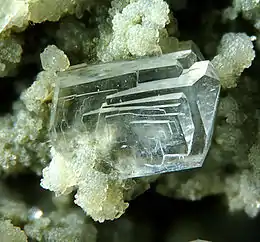Clinoptilolite
Clinoptilolite is a natural zeolite composed of a microporous arrangement of silica and alumina tetrahedra. It has the complex formula: (Na,K,Ca)2-3Al3(Al,Si)2Si13O36·12H2O. It forms as white, green to reddish tabular monoclinic tectosilicate crystals with a Mohs hardness of 3.5 to 4 and a specific gravity of 2.1 to 2.2. It commonly occurs as a devitrification product of volcanic glass shards in tuff and as vesicle fillings in basalts, andesites and rhyolites. It was described in 1969 from an occurrence in the Barstow Formation, San Bernardino County, California. Sodium levels in clinoptilolite are generally higher than potassium levels, as is the case with the San Bernardino Barstow Formation, but there are sources that are potassium-rich and have minimal sodium.[4]
| Clinoptilolite | |
|---|---|
 Clinoptilolite-Na | |
| General | |
| Category | Tectosilicates Zeolites |
| Formula (repeating unit) | (Na,K,Ca)2-3Al3(Al,Si)2Si13O36·12H2O |
| Strunz classification | 9.GE.05 |
| Crystal system | Monoclinic |
| Space group | C2/m (no. 12) |
| Identification | |
| Mohs scale hardness | 3 1⁄2 - 4 |
| Luster | Vitreous |
| References | [1][2][3] |
It forms a series with heulandite:
- Clinoptilolite-Ca – heulandite-Ca solid solution series
- Clinoptilolite-K – heulandite-K solid solution series
- Clinoptilolite-Na – heulandite-Na solid solution series
Use of clinoptilolite in industry and academia focuses on its ion exchange properties having a strong exchange affinity for ammonium (NH4+). A typical example of this is in its use as an enzyme-based urea sensor.[5]
Research is generally focused around the shores of the Aegean Sea due to the abundance of natural clinoptilolite in easily accessible surface deposits.[6]
The name is derived from the Greek words klino (κλίνω; "oblique"), ptylon (φτερών; "feather"), and lithos (λίθος; "stone").
United States sources of clinoptilolite are found in California, Idaho, New Mexico, Oregon, and Texas deposits.[7]
Use
Clinoptilolite has many applications due to its effect as a molecular sieve, among others as an additive for building materials, as aggregate in horticulture, as an additive to cattle feed, as an additive in household products, as a desiccant, and in environmental technology.
Clinoptilolite was used on a large scale in the nuclear disaster of Chernobyl. There, the mineral was used on the one hand as an ion exchanger in cleaning plants to treat radioactively contaminated wastewater. On the other hand, it was added to cattle feed in order to bind and eliminate radioactive cations such as 137cesium as an ion exchanger in the digestive tract.[8]
Clinoptilolite is marketed within the EU as medical product and is associated with scientifically unproven healing effects. It is not approved as a food supplement for human use due to the Novel Food Regulation. In Germany, it was therefore registered in December 2011 by the Federal Office of Consumer Protection and Food Safety under the rapid alert number "2011/1849" as an unauthorized novel food ingredient in food supplements.[9]
Clinoptinolite of sedimentary origin may be used as a "technological" additive in animal feed. It then has the function of binder. The European Commission authorized clinoptinolite in animal nutrition for all animal species in 2013.[10] Only clinoptinolite of sedimentary origin is allowed.
See also
References
- Webmineral data
- Mindat with location data
- Smyth, J.R.; Spaid, A.T.; Bish, D.L. (1990). "Crystal structures of a natural and a Cs-exchanged clinoptilolite natural sample". American Mineralogist. 75: 522–528.
- Sheppard and Gude (1969). "Geological Survey Professional Paper 634: Diagenesis of Tuffs in the Barstow Formation, Mud Hills, San Bernardino County, California" (PDF). USGS.
- Saiapina, O. Y.; Pyeshkova, V. M.; Soldatkin, O. O.; Melnik, V. G.; Kurç, B. Akata; Walcarius, A.; Dzyadevych, S. V.; Jaffrezic-Renault, N. (2011-10-10). "Conductometric enzyme biosensors based on natural zeolite clinoptilolite for urea determination". Materials Science and Engineering: C. 31 (7): 1490–1497. doi:10.1016/j.msec.2011.06.003. ISSN 0928-4931.
- Fuoco, Domenico (2012-03-05). "A New Method for Characterization of Natural Zeolites and Organic Nanostructure Using Atomic Force Microscopy". Nanomaterials. 2 (1): 79–91. doi:10.3390/nano2010079. ISSN 2079-4991. PMC 5327878. PMID 28348297.
- "USGS Mineral Commodity Summary 2019 Zeolites (Natural)" (PDF).
- Institut für Geologie der Uni Bern: Zeolithe – Entstehung und Vorkommen. Fallbeispiel Tschernobyl (PDF, 7 MB)
- Pharmazeutische Zeitung online: Klinoptilolith. Remedy or humbug?
- COMMISSION IMPLEMENTING REGULATION (EU) No 651/2013 of 9 July 2013